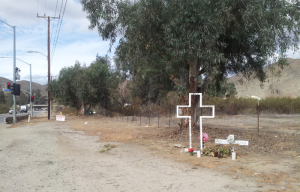What the Media Won’t Tell You about the Roadside Cross in California

If you read media reports about the American Humanist Association’s letter to the City of Lake Elsinore, California, complaining about a roadside Christian cross there, you might get the wrong idea. While it’s true that the cross in question was put up to memorialize a resident who was killed in a pedestrian accident, there are several things that the news reports aren’t telling you.
The cross in question was erected in May 2012, and was actually removed by the city in December 2013 (after being up for a year and a half), after some residents complained about it. The city (not the family of the decedent) put the cross back up a few days after taking it down, then promised the complaining parties that it would be removed again after the holidays, giving a specific date of January 6, 2014. To the shock of the complaining parties, the city left the cross up after January 6, saying it would come down in March.
The cross in question was not a typical, relatively discreet roadside cross, but was large and highly visible. In fact, it was not even just two crossed boards like most crosses, but was a more sophisticated design that many residents were no doubt starting to see as a permanent landmark. The cross was placed in a conspicuous location at the bottom of an exit ramp of an Interstate highway (I-15), making it a very noticeable fixture (on public property, of course) that everyone entering the city would see.
After public officials broke the January 6 promise, the complaining parties had lost trust in the city and asked the American Humanist Association’s Appignani Humanist Legal Center for help. On March 4, we sent our letter.
It’s noteworthy that the City of Lake Elsinore has a notorious reputation for violating the Establishment Clause, having recently lost a major Establishment Clause case in federal court after city officials defiantly tried to erect a public monument that included a Christian cross on it. Their interest in promoting Christianity is well-documented.
The AHA sent the letter only after it became clear that the city had been dishonest to the complaining parties, that the large cross could be replaced with a more appropriate memorial, and that the only way to remedy the situation was to let the city know that we were serious. A temporary memorial placed by a loved one immediately after a fatal accident could be understandable, but that’s not what this was.
Of course, challenging religious symbols in the United States always generates controversy, and in this particular situation perhaps even more than usual, but we see this as critically important work. When we don’t challenge government-placed Christian crosses on public land, we allow Christianity to become the de-facto religion of the country, giving credibility to those who would claim that America is a “Christian nation.” Like most people, humanists have little interest in fighting over trivial matters, but “Christian nation” thinking is no trivial matter.
